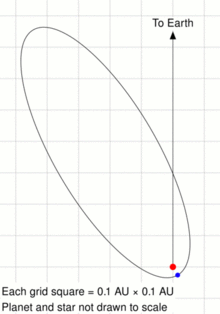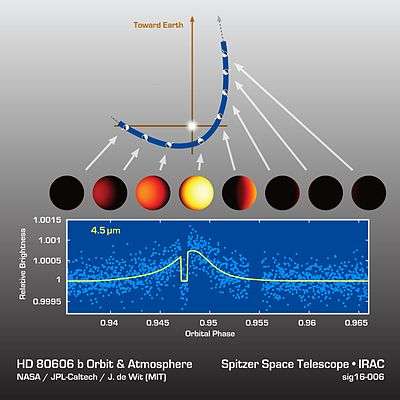HD 80606 b
| Exoplanet | List of exoplanets | |
|---|---|---|
 to scale with Jupiter | ||
| Parent star | ||
| Star | HD 80606 | |
| Constellation | Ursa Major | |
| Right ascension | (α) | 09h 22m 37.5679s |
| Declination | (δ) | +50° 36′ 13.397″ |
| Apparent magnitude | (mV) | 8.93 |
| Distance | 190 ly (58 pc) | |
| Spectral type | G5V | |
| Orbital elements | ||
| Semi-major axis | (a) | 0.453 ± 0.015[1] AU (67.8 Gm) |
| 7.8 mas | ||
| Periastron | (q) | 0.0301 AU (4.50 Gm) |
| Apastron | (Q) | 0.876 AU (131 Gm) |
| Eccentricity | (e) | 0.9336 ± 0.0002[2] |
| Orbital period | (P) | 111.436 ± 0.003[1] d (0.30509 y) |
| (2674.5 h) | ||
| Orbital speed | (υ) | 31.7[notes 1] km/s |
| Inclination | (i) | 89.285 ± 0.023[2]° |
| Argument of periastron |
(ω) | 300.4977 ± 0.0045[2]° |
| Time of periastron | (T0) | 2,454,424.857 ± 0.05[1] JD |
| Time of transit | (Tt) | 2,454,876.344 ± 0.011[2] JD |
| Time of eclipse | (Te) | 2,454,424.736 ± 0.003[3] JD |
| Semi-amplitude | (K) | 472 ± 5[1] m/s |
| Physical characteristics | ||
| Mass | (m) | 4.0 ± 0.3[1] MJ |
| Radius | (r) | 0.921 ± 0.036[4] RJ |
| Density | (ρ) | 4440 ± 240[2] kg m−3 |
| Surface gravity | (g) | 9.6 g |
| Temperature | (T) | at periastron: 1500 |
| Discovery information | ||
| Discovery date | 4 April 2001[5] | |
| Discoverer(s) | Geneva Extrasolar Planet Search | |
| Discovery method | Radial velocity | |
| Other detection methods | Orbital phase reflected light variations Transit (secondary) | |
| Discovery site | Haute-Provence Observatory | |
| Discovery status | Published[6] | |
| Other designations | ||
| Struve 1341 B b, HIP 45982 b | ||
| Database references | ||
| Extrasolar Planets Encyclopaedia | data | |
| SIMBAD | data | |
| Exoplanet Archive | data | |
| Open Exoplanet Catalogue | data | |
HD 80606 b (also Struve 1341 B b or HIP 45982 b) is an eccentric Jupiter 190 light-years from the Sun in the constellation of Ursa Major. HD 80606 b was discovered orbiting the star Struve 1341 B in April 2001 by a team led by Michel Mayor and Didier Queloz.[5] With a mass 4 times that of Jupiter, it is a gas giant. Because the planet transits the host star its radius can be determined using the transit method and was found to be slightly smaller than Jupiter's. Its density is slightly less than Earth's.[2]
Physical properties

HD 80606 b has the most eccentric orbit of any known planet after HD 20782 b. Its eccentricity is 0.9336, comparable to Halley's Comet. The eccentricity may be a result of the Kozai mechanism, which would occur if the planet's orbit is significantly inclined to that of the binary stars. This interpretation is supported by measurements of the Rossiter–McLaughlin effect, which indicate that the planet's orbit may be significantly inclined (by approximately 50 degrees[7]) to the rotational axis of the star, a configuration which would be expected if the Kozai mechanism were responsible for the orbit.[1]
As a result of this high eccentricity, the planet's distance from its star varies from 0.03 to 0.88 AU. At apastron it would receive an insolation similar to that of Earth, while at periastron the insolation would be around 800 times greater, far more than that experienced by Mercury in the Solar System. In 2009, the eclipse of HD 80606 b by its parent star was detected, allowing measurements of the planet's temperature to be made as the planet passed through periastron. These measurements indicated that the temperature rose from around 800 K (500 °C / 1000 °F) to 1500 K (1200 °C / 2200 °F) in just 6 hours.[3]
An observer above the cloud tops of the gas giant would see the parent star swell to 30 times the apparent size of the Sun in our own sky.[8]

The transit was detected using a Celestron 35-cm Schmidt–Cassegrain telescope.[2] Prior to the large data release of the Kepler Mission in February 2011, HD 80606 b has the longest orbital period of any known transiting planet. It takes 12.1 hours to transit its star.
The transit of 14 January 2010 was partially observed by MOST; but there were equipment failures over part of this time, and the 8 January secondary transit was entirely lost.[9] The midpoint of the next transit is 1 February 2013 11:37 UT.[10]
Weather
The planet has wild variations in its weather as it orbits its parent star. Computer models predict the planet heats up 555 °C (1,000 °F) in just a matter of hours triggering "shock wave storms" with winds that move faster than the speed of sound, at 3 miles per second.[3][11]

Notes
- ↑ From perimeter of the orbit divided by orbital period.
References
- 1 2 3 4 5 6 Moutou, C.; et al. (April 2009). "Photometric and spectroscopic detection of the primary transit of the 111-day-period planet HD 80606 b". Astronomy and Astrophysics. 498 (5): L5–L8. arXiv:0902.4457
 . Bibcode:2009A&A...498L...5M. doi:10.1051/0004-6361/200911954.
. Bibcode:2009A&A...498L...5M. doi:10.1051/0004-6361/200911954. - 1 2 3 4 5 6 7 Fossey, S. J.; Waldman, I. P.; Kipping, D. M. (2009). "Detection of a transit by the planetary companion of HD 80606". Monthly Notices of the Royal Astronomical Society: Letters. 396: L16–L20. arXiv:0902.4616
 . Bibcode:2009MNRAS.396L..16F. doi:10.1111/j.1745-3933.2009.00653.x.
. Bibcode:2009MNRAS.396L..16F. doi:10.1111/j.1745-3933.2009.00653.x. - 1 2 3 Laughlin, G.; et al. (2009). "Rapid heating of the atmosphere of an extrasolar planet". Nature. 457 (7229): 562–564. Bibcode:2009Natur.457..562L. doi:10.1038/nature07649. PMID 19177124.
- ↑ Hidas, M. G.; et al. (2010). "An ingress and a complete transit of HD 80606 b". arXiv:1002.1052
 [astro-ph.EP].
[astro-ph.EP]. - 1 2 "Exoplanets: The Hunt Continues!" (Press release). Garching, Germany: European Southern Observatory. 4 April 2001. Retrieved 27 December 2012.
- ↑ Naef, D.; et al. (2001). "HD 80606 b, a planet on an extremely elongated orbit". Astronomy and Astrophysics. 375 (2): L27–L30. arXiv:astro-ph/0106256
 . Bibcode:2001A&A...375L..27N. doi:10.1051/0004-6361:20010853.
. Bibcode:2001A&A...375L..27N. doi:10.1051/0004-6361:20010853. - ↑ PONT; et al. "Spin-orbit misalignment in the HD 80606 planetary system". Astronomy & Astrophysics. Retrieved 7 February 2013.
- ↑ Robert Massey and Anita Heward (21 April 2009). "RAS PN 09/23 (NAM 10): London students find Jupiter-sized oddball planet". The Royal Astronomical Society. Retrieved 15 July 2009.
- ↑ Jessica E. Roberts, Jason W. Barnes, Jason F. Rowe, Jonathan F. Fortney (2012). "MOST Space Telescope Photometry of the 2010 January Transit of Extrasolar Planet HD80606b". arXiv:1212.0285
 . Bibcode:2013ApJ...762...55R. doi:10.1088/0004-637X/762/1/55.
. Bibcode:2013ApJ...762...55R. doi:10.1088/0004-637X/762/1/55. - ↑ HD 80606 Transit Times - Variable Star and Exoplanets
- ↑ "Exoplanet Sees Extreme Heat Waves". Space.com. 28 January 2009.
External links
![]() Media related to HD 80606 b at Wikimedia Commons
Media related to HD 80606 b at Wikimedia Commons
Coordinates: ![]() 09h 22m 37.5679s, +50° 36′ 13.397″
09h 22m 37.5679s, +50° 36′ 13.397″